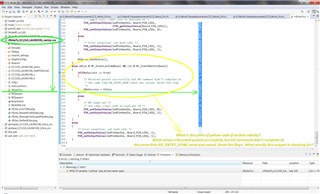Other Parts Discussed in Thread: CC1310
Hi Experts,
Good day.
Would you help to obtain an understanding of:
Q1: I'm studying the example "rfEchoTx_CC1310_LAUNCHXL_nortos_ccs", So I can't understand the point of one "if-snippent" in the example - it is on the picture attached to this letter.
Q2: Would U explain the point of the field "pastTrig" of the structure
struct __RFC_STRUCT rfc_CMD_PROP_TX_ADV_s {
.....
struct {
uint8_t triggerType:4; //!< The type of trigger
uint8_t bEnaCmd:1; //!< \brief 0: No alternative trigger command<br>
//!< 1: CMD_TRIGGER can be used as an alternative trigger
uint8_t triggerNo:2; //!< The trigger number of the CMD_TRIGGER command that triggers this action
uint8_t pastTrig:1; //!< \brief 0: A trigger in the past is never triggered, or for the start of commands, give an error<br>
//!< 1: A trigger in the past is triggered as soon as possible
} startTrigger (endTrigger);
....
I can't understand what means :
0: A trigger in the past is never triggered, or for the start of commands, give an error<br>
1: A trigger in the past is triggered as soon as possible
what is the behavior/point? Would you explain it more widely and in detail
Please advise.
Regards,
Josel


